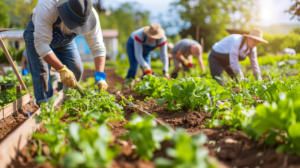In today’s world, where economic inequality is rising and communities often feel disconnected, there’s a growing need for fresh, innovative approaches to economic stability. Enter economic solidarity, cooperative models, and mutual aid—concepts that transform how we think about business, community, and support systems. Let’s dive into these ideas and see how they can make a real difference in our lives.
What is Economic Solidarity?
Imagine a world where economic systems prioritize the community’s welfare over individual profit. Sounds dreamy, right? That’s the essence of economic solidarity. It’s all about creating frameworks that promote social cohesion, mutual support, and shared prosperity, turning the competitive, dog-eat-dog mentality on its head. Instead of “every person for themselves,” it’s “we’re all in this together.”
Cooperative Models: Sharing the Wealth and Power
Cooperatives are the heart and soul of economic solidarity. These are businesses owned and run by the people who use their services or work there. Unlike traditional companies that aim to maximize profits for a few shareholders, cooperatives focus on meeting the needs of their members.
Worker Cooperatives
Think of a place where everyone who works there also owns a piece of the action. In worker cooperatives, employees have a say in the business decisions and share the profits. This means everyone is motivated to work hard because they directly benefit from their efforts.
Consumer Cooperatives
Imagine a grocery store where the shoppers own the place. Consumer cooperatives are owned by the people who buy their products or services. By pooling their resources, members get better deals and have a say in how the business is run. Plus, these co-ops often focus on ethical and sustainable practices, reflecting their members’ values.
Producer Cooperatives
Picture small farmers or artisans banding together to sell their goods. Producer cooperatives allow these producers to combine their strengths, process and market their products more effectively, and get fair prices. It’s all about strength in numbers.
Mutual Aid: Neighbors Helping Neighbors
Mutual aid is the grassroots cousin of economic solidarity. It’s about communities coming together to support each other, sharing resources and services without expecting anything in return. Unlike charity, which can sometimes feel one-sided, mutual aid is based on equality and direct action.
- Grassroots Initiatives: These often start from the ground up, with community members identifying needs and stepping up to help. Whether it’s a community garden, a food pantry, or a neighborhood tool library, these initiatives thrive on local participation and cooperation.
- Disaster Response: When disaster strikes, mutual aid networks can mobilize quickly to provide essential services. They fill in the gaps left by traditional emergency responses, showing the power of community action in times of crisis.
- Long-Term Sustainability: While mutual aid addresses immediate needs, it also builds long-term resilience. By fostering networks of support and trust, communities are better prepared for future challenges. It’s like building a safety net woven from shared experiences and collective strength.
Real-Life Examples: Success Stories
Success in cooperative and community-based models is not just a theory; it’s a reality proven by several remarkable organizations around the world. These examples showcase how collective efforts and shared ownership can lead to impressive outcomes across various sectors. Here are a few standout success stories:
- Mondragon Corporation: This Spanish marvel is one of the world’s largest worker cooperatives, with over 80,000 employees across 250 businesses. Mondragon shows that cooperative models can scale and succeed on a grand level, blending economic efficiency with social responsibility.
- Park Slope Food Coop: Nestled in Brooklyn, New York, this consumer cooperative is a prime example of how community ownership can thrive in an urban setting. Members contribute labor to keep the store running smoothly, enjoying high-quality, ethically sourced groceries at lower prices.
- Mutual Aid Disaster Relief: This volunteer network steps in where traditional aid often falls short, focusing on marginalized communities during natural disasters. Their work highlights the importance of solidarity and community-led responses in times of need.
Building a Solidarity Economy
Creating a solidarity economy isn’t just a lofty goal; it’s a practical path forward. Here are a few strategies to make it happen:
- Education and Awareness: Spread the word about the benefits of cooperative models and mutual aid. Educational programs and public campaigns can help shift cultural perceptions towards valuing collective well-being.
- Policy Support: Governments can boost these initiatives by enacting supportive policies. Funding, tax incentives, and legal frameworks can help cooperative and mutual aid models flourish.
- Network Building: Connecting cooperatives and mutual aid groups can amplify their impact. By sharing resources and knowledge, these organizations can drive systemic change and support each other.
Economic solidarity, cooperative models, and mutual aid aren’t just theoretical ideas; they’re practical, powerful ways to build a fairer, more resilient society. By embracing these concepts, we can foster sustainable development, social justice, and community support. It’s about creating a world where everyone has a stake in the success and well-being of their community—a world where we’re all in this together.




